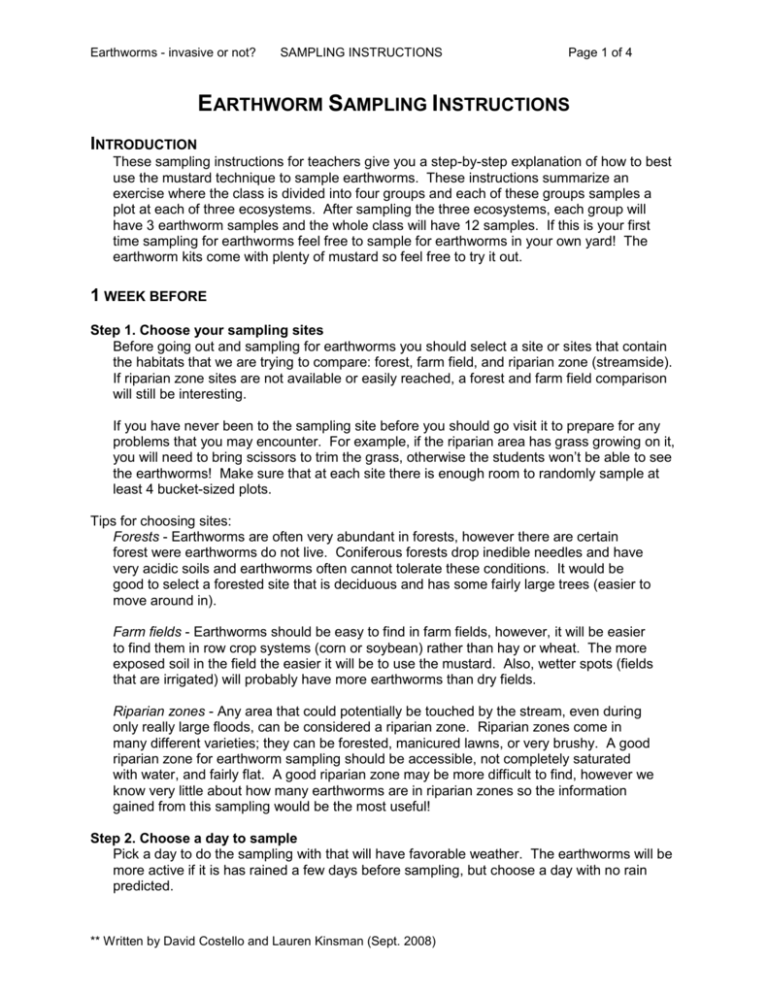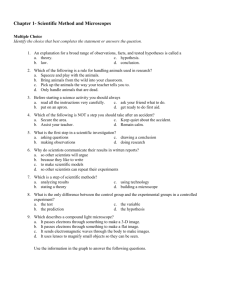Earthworm sampling instructions
advertisement

Earthworms - invasive or not? SAMPLING INSTRUCTIONS Page 1 of 4 EARTHWORM SAMPLING INSTRUCTIONS INTRODUCTION These sampling instructions for teachers give you a step-by-step explanation of how to best use the mustard technique to sample earthworms. These instructions summarize an exercise where the class is divided into four groups and each of these groups samples a plot at each of three ecosystems. After sampling the three ecosystems, each group will have 3 earthworm samples and the whole class will have 12 samples. If this is your first time sampling for earthworms feel free to sample for earthworms in your own yard! The earthworm kits come with plenty of mustard so feel free to try it out. 1 WEEK BEFORE Step 1. Choose your sampling sites Before going out and sampling for earthworms you should select a site or sites that contain the habitats that we are trying to compare: forest, farm field, and riparian zone (streamside). If riparian zone sites are not available or easily reached, a forest and farm field comparison will still be interesting. If you have never been to the sampling site before you should go visit it to prepare for any problems that you may encounter. For example, if the riparian area has grass growing on it, you will need to bring scissors to trim the grass, otherwise the students won’t be able to see the earthworms! Make sure that at each site there is enough room to randomly sample at least 4 bucket-sized plots. Tips for choosing sites: Forests - Earthworms are often very abundant in forests, however there are certain forest were earthworms do not live. Coniferous forests drop inedible needles and have very acidic soils and earthworms often cannot tolerate these conditions. It would be good to select a forested site that is deciduous and has some fairly large trees (easier to move around in). Farm fields - Earthworms should be easy to find in farm fields, however, it will be easier to find them in row crop systems (corn or soybean) rather than hay or wheat. The more exposed soil in the field the easier it will be to use the mustard. Also, wetter spots (fields that are irrigated) will probably have more earthworms than dry fields. Riparian zones - Any area that could potentially be touched by the stream, even during only really large floods, can be considered a riparian zone. Riparian zones come in many different varieties; they can be forested, manicured lawns, or very brushy. A good riparian zone for earthworm sampling should be accessible, not completely saturated with water, and fairly flat. A good riparian zone may be more difficult to find, however we know very little about how many earthworms are in riparian zones so the information gained from this sampling would be the most useful! Step 2. Choose a day to sample Pick a day to do the sampling with that will have favorable weather. The earthworms will be more active if it is has rained a few days before sampling, but choose a day with no rain predicted. ** Written by David Costello and Lauren Kinsman (Sept. 2008) Earthworms - invasive or not? SAMPLING INSTRUCTIONS Page 2 of 4 DAY BEFORE Step 1. Make the mustard solution The mustard solution should sit for at least 12 hours for maximum effectiveness, so it should be mixed one day before you sample. The final extracting solution contains 40 grams of powder to 1 gallon of water. If you are planning on sampling many times in the same day, it is much easier to mix up a thick mustard solution and dilute this in the field. Mustard slurry loses its effectiveness in about 1 month, so to conserve powder mix only the necessary amounts. If you use the mustard slurry technique make sure you sample near a water source (or bring water) because you will need water to dilute the mustard. Mustard solution (for 1 plot) 1. Fill a 1 gallon jug half full of warm water 2. Weigh out 40 g of mustard powder 3. Using a funnel, pour the mustard powder into the jug 4. Mix the solution thoroughly 5. Fill the 1 gallon jug the rest of the way with warm water 6. Let sit overnight Thick mustard slurry (for 10 plots) 1. Fill the 1 L Nalgene bottle 3/4 full of warm water 2. Weight out 400 g of mustard powder 3. Using a funnel, pour the mustard powder into the bottle 4. Mix the solution thoroughly 5. Fill the bottle the rest of the way with warm water 6. Let the slurry sit overnight 7. When ready to sample, measure out 100 mL of the slurry from the 1L bottle 8. Pour the 100 mL into a 1 gallon jug 9. Fill the 1 gallon jug with water Recommended: If you are planning sample all 3 of the ecosystems on the same day (or on days close together) you can make all the mustard you need at once by using 2 one-gallon jugs and the 1 L bottle. Fill the 2 jugs with the 40 gram/gallon mustard solution and make 1 L of the mustard slurry. This will give you enough mustard to sample the 12 recommended plots. Step 2. Assemble materials For sampling in the field: Mustard solution Sampling rings 1 gallon plastic jugs with caps (milk jugs work great) Plastic cups or bags to hold the worms (one for each sample plot) Clipboards (for students to fill out their data sheets) For the classroom: Identification book Trays to sort worms on Ethanol for earthworm preservation Whirl-Pak bags ** Written by David Costello and Lauren Kinsman (Sept. 2008) Earthworms - invasive or not? SAMPLING INSTRUCTIONS Page 3 of 4 SAMPLING FOR EARTHWORMS Step 1. Randomly choose sampling plots Random sampling is very important for estimating how many earthworms there are in an area. Earthworms are often found in patches and a good earthworm hunter could easily find the best earthworm habitats. However, if you only sample the good earthworm spots, then the estimate of how many earthworms there are in the field would be much greater than the actual number! Scientists sample randomly to avoid this kind of bias. There are many ways you can choose your random sampling spots: (1) throw a tennis ball (with eyes closed) and sample where it lands, (2) generate random numbers (www.random.org is a good website) and sample that number of steps from a starting point, (3) make a grid in the field and generate random sampling coordinates. It doesn’t matter which way you sample (you can use a completely different method) just make sure the students randomly sample. Step 2. Pour on the mustard Once the random plots are located, clear the surface of any vegetation or leaves and expose the soil. Some earthworms live in thick leaf litter, so when sampling the forest, look through the leaves for any earthworms that may be living in the leaves! Press the sampling ring into the soil to restrict the mustard to the sampling plot. If you have the concentrated mustard slurry, add 100 mL of the slurry to one gallon of water. Shake the mustard well and now it is ready to use. Pour on about ¼ of the solution or enough to saturate the soil and start the timer for 20 minutes. Collect all the earthworms that crawl out of the ground and continue to add the mustard solution until it is all gone. Try to keep the soil saturated but avoid letting the mustard solution pool up on the surface. After all of the mustard is added continue to monitor the plot because earthworms will continue to crawl out; the biggest ones often take the longest time to crawl out. Collect all the earthworms for 20 minutes before moving on to a new plot. Step 3. Pull out the earthworms The shallow earthworms will come crawling out of the ground as soon as the mustard is poured on so be sure the students are ready to grab. If some of the mustard leaks out of the sampling area it will irritate earthworms outside the plot, however those do not count and should not be part of the sample. The larger earthworms will come crawling out later, and often these worms do not crawl all the way out of the soil. It takes some patience to get these worms out because they can quickly retreat to their burrows never to be seen again. Tell the students to let the big worms come out almost all the way before trying to pull them out! There will be a contest for the classroom that finds the longest earthworm in SW Michigan, and broken earthworms will not count! Be sure to tell your class this and stress the importance of being patient when sampling! Step 4. Observe the environment While out at the sampling sites looking for earthworms, take this opportunity to have the students look around and take some notes on the environment. Not all of the students will be able to see the mustard in action at the same time, so have 2 groups sample for earthworms while the other 2 groups fill answer the questions on the student worksheet. The worksheet has 3 questions that must be answered about each site: (1) write observations about the soil, plants, other animals, (2) what are the earthworms eating, (3) have humans done anything that may affect earthworms. The introductory lecture before sampling should help the students fill out their sampling worksheet. ** Written by David Costello and Lauren Kinsman (Sept. 2008) Earthworms - invasive or not? SAMPLING INSTRUCTIONS Page 4 of 4 Step 5. Identify and count the earthworms The earthworms collected in the field can be examined either alive or dead, depending on your comfort level with preserving the earthworms. The earthworms will squirm while being preserved (however this is the most humane way to kill and preserve them) so if your students are squeamish, you may want to examine them alive. Also, the level of identification may depend on the grade level of the students. If you want to identify the earthworms to species they will need to be preserved so you can look at them under a microscope. At a minimum, all grades should be able to look at the color, size, and maturity of the earthworms and be able to divide them into broad groups. This broad generalization is useful because color says something about where they feed, size can indicate how much they eat, and the clitellum is a very obvious sign of sexual maturity. Step 6. Preserve and send the earthworms to me As a final step I would like you to preserve the earthworms and send them to me so that I can add this sampling to my dataset. This is something you will want to mention to your students, so that they know they are helping a “real scientist” gather important data. Please keep each sample (all the worms from within one plot) in a separate well labeled container. For labels you can just write in pencil the important information (school, teacher, date, ecosystem sampled) on a small piece of 3x5 index card and put that directly in the Whirl-pak bag with the preserved sample. I preserve earthworms in 70% ethanol but you can use whatever is Farm field available to you (isopropyl alcohol, 95% ethanol), however, I 8/24/08 would not use anything much less concentrated than 70%. Mr. Costello Ask a chemistry teacher or your GK-12 fellow if you need help Ford Elementary getting ethanol. The preserved earthworms may begin to rot Example of the information if they sit in dirty ethanol too long, so get them to me quickly needed on a sample tag to avoid the smell. When your samples are preserved please mail them to me or give them to your GK-12 Fellow. If you mail the earthworms pour off the ethanol, and reseal the Whirl-pak bag. The earthworms will stay moist enough with just the ethanol on them to survive the trip. Mail the earthworms to: David Costello University of Notre Dame 107 Galvin Life Sciences Notre Dame, IN 46556 When you send the samples or give them to your fellow please email me (dcostel2@nd.edu) so I know to expect them. Also, please fill out the teacher worksheet for my records and send that with the samples. NOTE: The final two pages of these sampling instructions can be modified and used as a handout for the students. Amend these instructions to suit your class by changing the random sampling to the method you will use, include the exact features you want the students to identify on the earthworms, and delete the final step and this will make a useful reference tool for the students. Check the KBS GK-12 website for the original word document or email me for the file. Thanks again and happy worming! ** Written by David Costello and Lauren Kinsman (Sept. 2008)








